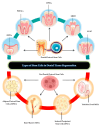Regenerative Strategies in Dentistry: Harnessing Stem Cells, Biomaterials and Bioactive Materials for Tissue Repair
- PMID: 40305324
- PMCID: PMC12025071
- DOI: 10.3390/biom15040546
Regenerative Strategies in Dentistry: Harnessing Stem Cells, Biomaterials and Bioactive Materials for Tissue Repair
Abstract
Advanced bioengineering, popularly known as regenerative dentistry, has emerged and is steadily developing with the aim of replacement of lost or injured tissues in the mouth using stem cells and other biomaterials. Conventional therapies for reparative dentistry, for instance fillings or crowns, mainly entail the replenishment of affected tissues without much concern given to the regeneration of tissues. However, these methods do not enable the natural function and aesthetics of the teeth to be maintained in the long term. There are several regenerative strategies that offer the potential to address these limitations to the extent of biologically restoring the function of teeth and their components, like pulp, dentin, bone, and periodontal tissues. Hence, stem cells, especially dental tissue derived stem cells, such as dental pulp stem cells, periodontal ligament stem cells, or apical papilla stem cells, are quite promising in this regard. These stem cells have the potentiality of generating precise dental cell lineages and thus are vital for tissue healing and renewal. Further, hydrogels, growth factors, and synthetic scaffolds help in supporting the stem cells for growth, proliferation, and differentiation into functional tissues. This review aims at describing the process of stem cell-based tissue repair biomaterials in dental regeneration, and also looks into the practice and prospects of regenerative dentistry, analysing several case reports and clinical investigations that demonstrate the efficacy and limitations of the technique. Nonetheless, the tremendous potential for regenerative dentistry is a reality that is currently challenged by biological and technical constraints, such as scarcity of stem cell sources, inadequate vascularization, and the integration of the materials used in the procedure. As we move forward, the prospects for regenerative dentistry are in subsequent developments of stem cell technology, biomaterial optimization, and individualized treatment methods, which might become increasingly integrated in dental practices globally. However, there are regulatory, ethical and economic issues that may pose a hurdle in the further advancement of this discipline.
Keywords: biomaterials; dental pulp; periodontal ligament; regenerative dentistry; stem cells; tissue regeneration.
Conflict of interest statement
The authors declare no conflicts of interest.
Figures


References
-
- Torvi S., Munniswamy K. Regenerative dentistry: Current and future perspectives to rejuvenate and reclaim dental tissues. J. Int. Clin. Dent. Res. Organ. 2014;6:112. doi: 10.4103/2231-0754.143496. - DOI
-
- Cohn S.A. Endodontic therapy 6th Edition: By Franklin S. Weine. Aust. Endod. J. 2004;30:33. doi: 10.1111/j.1747-4477.2004.tb00168.x. - DOI
-
- Perrone M. Advancements in regenerative dentistry. J. Stem Cells Res. 2004;5:62. doi: 10.52793/JSCR.2024.5(2)-62. - DOI
Publication types
MeSH terms
Substances
LinkOut - more resources
Full Text Sources
Medical
Research Materials

